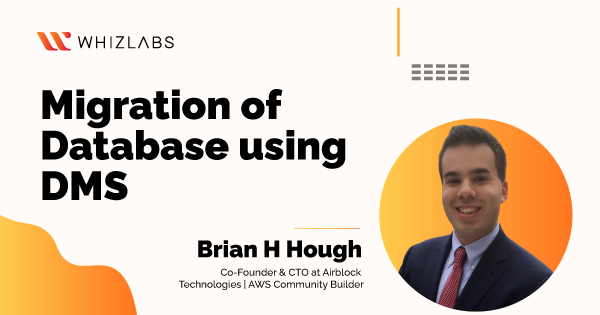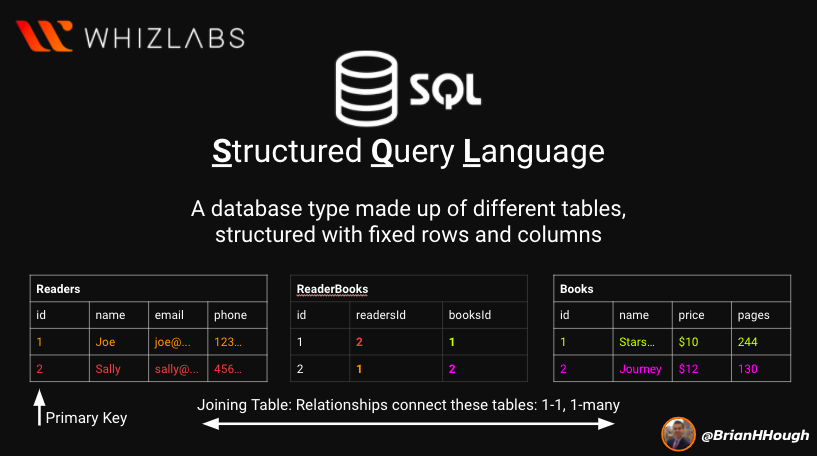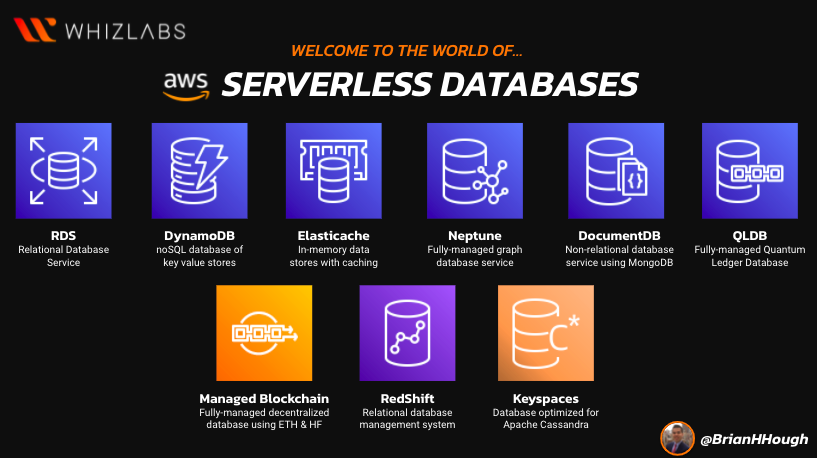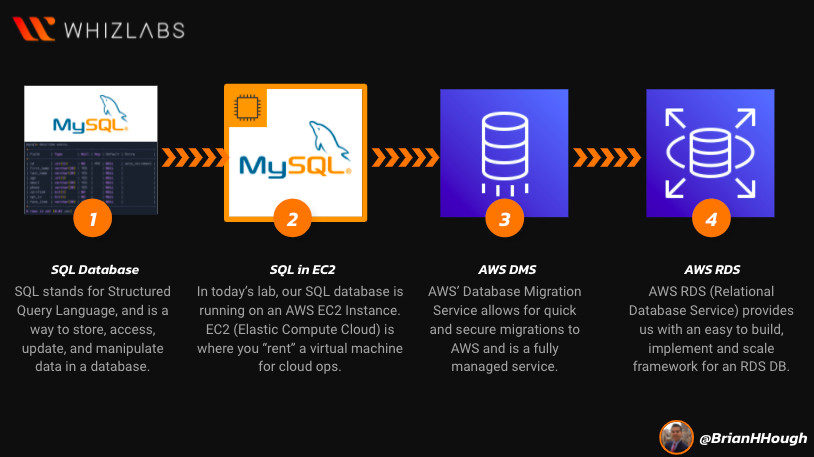AWS Database Migration Service (DMS) allows the migration of databases to AWS in a secure way. It also supports homogeneous migrations, for instance, Oracle to Oracle, along with heterogeneous migrations, i.e. between different database platforms like Oracle to Amazon Aurora.
To date, over 5,50,000 databases have been migrated using the AWS DMS.
Whizlabs conducted an elaborative webinar on ‘AWS Database Migrations with DMS’, with Mr. Brian H. Hough on 8th January, 2022. We have published a course about AWS DMS.
The agenda of the Webinar was to learn:
- SQL
- AWS Serverless Database Ecosystem
- RDS
- AWS DMS
Brian H. Hough is a certified blockchain and cloud developer, AWS Community Builder, and passionate advocate for innovation. He got his start in tech as the Chief Communications Officer for 8 Decimal Capital, a $60M global blockchain VC fund, while he worked as the Google Arts & Culture Project Coordinator at the Harvard Kennedy School’s Project on American Indian Economic Development.
He is a Web2 and Web3 Developer, and the CTO and co-founder of AirBlock Technologies that is digitising supply chain and aerospace. He also runs the TechStack Playbook Podcast whose overall goal is to make App Software and tech fun and accessible bringing more inclusion to the tech community globally. He has been through multiple Hackathons, and won the ETHOnline ’21 hackathon by building HelpMeDev.io, a decentralised founder-entrepreneur marketplace.
What is SQL?
SQL stands for Structured Query Language, made up of tables that are structured with fixed rows and columns, wherein you have a primary key for a primary table.
For instance, we are tracking a library wherein there are multiple readers who are reading books. The two databases are readers and books. And there exists an ID1, that is Joe, and another ID that is Sally. In the books, we may have one book whose name is Star and another book called Journey, and we want to track all the different readers, the different books, and who is reading what.
So, under the joining table, this is basically mapping the relationship between the two tables, wherein you might have Sally who has Book1, and Joe with Book2. Here comes SQL into play because it helps you sort the fixed excel spreadsheets like tables to help you map and track your data.
If we go on expanding the whole concept of database, there are multiple databases available other than SQL, for example:
- DynamoDB, a noSQL Database, that works based on the key-value pairs, which is exactly opposite of SQL
- Elasticache, an In-memory data stores with caching, graph database, such as how social media accounts are tracking relationships more closely
- Neptune, a fully-managed graph database service
- MongoDB, a document-oriented database program
- DocumentDB, a non-relational document database
- QLDB, for having a fully immutable Quantum Ledger Database
- Blockchain, a decentralised type of database, specifically focussing on Ethereum for making nodes and then hyperledger for a private provisioned blockchain network
- Redshift, a relational database management service for analytics
- Keyspaces, which leverages Apache Cassandra for a database optimised for that kind of database.
This webinar was focused on RDS, the relational database service, which helps you with various services like Patching and Updating, done by the database management system.
AWS has extracted that work out of the overall flow, allowing the user to focus on scaling the database and using it effectively, putting aside worrying about the security patches, for they are already being managed. AWS is highly efficient and scalable, balancing top security with low cost.
It also has multiple database engines like Aurora, Postgres, MySQL, Microsoft SQL Server, Oracle, and MariaDB, to name a few.
SQL and Amazon RDS
- SQL is a self-managed database, i.e., you will have to manage the patching, updation of the security, and all the management of the database by yourself. This means managing the front end, backend, the database layer and more.
- Amazon RDS is a relational database as a service, which enables it to handle failovers, software update patches, data backups, and optimization for you. So, the database is optimised, ready, and working and you don’t have to worry about making the database work and operate. It supports 6 database engines including SQL server.
Process Overview
- Use the AWS DMS to connect SQL to RDS.
- Put SQL into EC2(Elastic Cloud Compute), which is a compute service that we rent from AWS, which means that we rent Virtual Machines for Cloud ops from AWS. This saves us from building all the infrastructure and the hardware, which is a costly and time consuming process.
- With the help of AWS, we are able to rent space from virtual machines that are ready to use and put the SQL database into a MySQL server, further executing it on EC2.
- Use the AWS DMS to migrate the SQL to RDS and this is a fully managed service which is fast and secure, and helps us pipe our data from MySQL server into RDS, the relational database service.making it easy to build, implement and scale.
The Solution Architecture
- Log in to the AWS Management Console provided by Whizlabs.
- Built within an AWS Cloud region, a virtual private cloud that contains the Security Group, inside which we have an EC2 instance running on My SQL Server.
- Create an instance of RDS as the database.
- Create a task to migrate all the inputs of MySQL into RDS.
- The MySQL connects with AWS DMS, which further connects with AWS RDS, and then back the same. This is how the RDS is updated based on the inputs it is receiving.
The content has been defined thoroughly with great clarity on the concepts. Keep learning with us for more amazing content.
- Top 25 DevSecOps Interview Question and Answers for 2024 - March 1, 2023
- How to prepare for VMware Certified Technical Associate [VCTA-DCV] Certification? - February 14, 2023
- Top 20 Cloud Influencers in 2024 - January 31, 2023
- 25 Free Question on SC-100: Microsoft Cybersecurity Architect - January 27, 2023
- Preparation Guide on MS-101: Microsoft 365 Mobility and Security - December 26, 2022
- Exam tips to prepare for Certified Kubernetes Administrator: CKA Exam - November 24, 2022
- Top Hands-On Labs To Prepare For AWS Certified Cloud Practitioner Certification - October 27, 2022
- Why do you need to upskill your teams with the Azure AI fundamentals? - October 11, 2022




